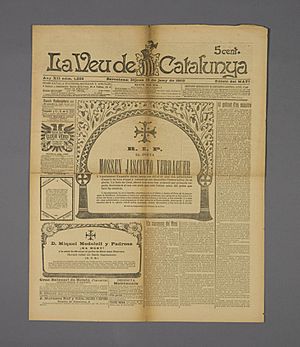La Veu de Catalunya facts for kids
 |
|
| Founded | 1 January 1899 |
|---|---|
| Language | Catalan |
| Ceased publication | 8 January 1937 |
| Headquarters | Barcelona |
| ISSN | 1577-2764 |
La Veu de Catalunya (which means The Voice of Catalonia) was an important Catalan newspaper. It was started by Enric Prat de la Riba and published in Barcelona. The newspaper ran from January 1, 1899, until January 8, 1937, publishing two editions every day.
This newspaper was the main voice for the ideas of the Lliga Regionalista, a political group. It supported the idea of "Autonomia" for Catalonia, which meant having more self-rule. It also promoted the normal use of the Catalan language in public and in schools. La Veu was a very modern newspaper for its time. It had different sections, reporters in many places, and a team of both young and experienced journalists. It was the longest-running Catalan newspaper of the 20th century, published daily for 38 years. Its special title design, made by Domènec i Montaner, showed an eagle with four stripes. Many experts, like Josep Pla and Eugeni Xammar, have called La Veu the best Catalan newspaper ever.
Before this newspaper, another publication called Diari Català also used the name La Veu de Catalunya for a short time in 1880. This happened when Diari Català was temporarily stopped from publishing.
The Story of La Veu de Catalunya
The newspaper "La Veu," as many people called it, grew out of an earlier weekly magazine with the same name. This weekly was started in 1891 by Narcís Verdaguer, Joaquim Cabot, and Jaume Collell. It became a daily newspaper in December 1898. Many important writers and politicians, like Francesc Cambó and Josep Puig i Cadafalch, wrote for the weekly. When it became a daily newspaper, Enric Prat de la Riba led it. He made sure it focused on politics and supported the goals of the Regionalist League.
The newspaper was stopped from publishing several times. This happened in 1900, 1901, 1902, and 1905 because of certain articles it published. For example, in 1902, its editor was arrested for printing an article about winemakers from Roussillon. In 1917, it was stopped again to prevent it from reporting on a big meeting of politicians. To get around these bans, the newspaper often changed its name. It appeared under names like La Creu de Catalunya or Diari de Catalunya.
On November 25, 1905, a group of soldiers attacked the newspaper's offices. They were angry about a cartoon by Junceda. This event is known as the "Fets del Cu-Cut!" (Facts of Cu-Cut!). This attack helped lead to the creation of Catalan Solidarity. This was an alliance of Catalan political parties that won many seats in the 1907 elections.
In July 1936, during the start of the Spanish Civil War, the newspaper's offices were taken over. It continued to be published, but its name changed to show new political ideas. It was called things like Diari de l'autonomia i de la República (Republic and Autonomous Newspaper) and Diari antifeixista controlat pel Comitè Obrer (Anti-fascist newspaper controlled by workers' committee).
How La Veu Influenced Journalism
La Veu had a very big impact on society and politics in the early 1900s. It was a modern newspaper that helped make journalism a more professional job. It had a large network of writers and reporters all over the world. Its journalists even created some of the first guides for good journalism. They set rules for writing articles, checking facts, and designing pages.
Many famous politicians, writers, and journalists wrote for La Veu. Some of them include Enric Prat de la Riba, Francesc Cambó, Joan Maragall, and Josep Pla. Eugenio d'Ors wrote a daily column called "Glosari" from 1906 to 1921. Josep Carner wrote poems, and Josep Maria de Sagarra translated works.
In 1909, Raimon Casellas and Joaquim Folch i Torres started the "Pàgina Artística" (Artistic Page). This section featured art reviews. From this page, the term "Noucentisme" was first used. This word was created by Eugenio d'Ors and described a new cultural movement in Catalonia.
Between 1929 and 1930, Llucieta Canyà led a daily section called "Món feminí" (Feminine World). This section was very important for understanding the conservative women's movement in Spain before the Civil War.
Manuel Brunet was in charge of the cultural section. This section began publishing the first 28 songs of Dante's famous poem, Divine Comedy. These were translated into Catalan by Josep Maria de Sagarra. However, the Civil War stopped this project from being finished.
Besides Prat de la Riba, other people who directed the newspaper included Josep Morató i Grau, Joaquim Pellicena i Camacho, and Ramon d'Abadal i de Vinyals.
See also
 In Spanish: La Veu de Catalunya para niños
In Spanish: La Veu de Catalunya para niños

